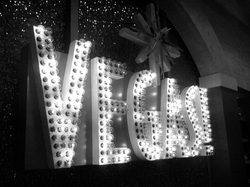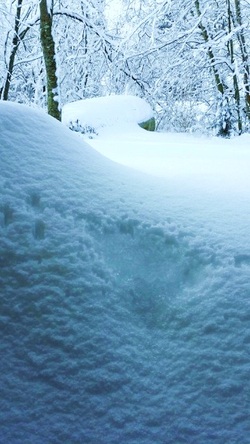
Even in its dessert state, the region contains underground water. That means springs. And wells. Over the years, these subterranean waters have refreshed Native American tribes like the Paiute, Mexican explorers (“Las Vegas” is Spanish for “the meadows”), pioneers, Mormon settlers, and miners.
By the early 1900’s, brothels and gambling establishments blossomed in Las Vegas, creating what critics would label a moral “swamp” in the clear desert air. The red light houses and gaming joints catered first to miners, and later
to the workers laboring heroically to build the Hoover Dam.
Once the dam was completed in the mid-1930’s, the workers moved on. But the military was moving in, using the desert for training and testing. The establishments of questionable repute that had welcomed the Hoover Dam workers were just as happy to embrace the military personnel. It was at this time that electricity generated by the brand new dam touched Las Vegas with fire—electric fire—the incandescence that first gave Las Vegas its glow and gleam, and its nickname of “Glitter Gulch”.
Notwithstanding its electric brilliance, Las Vegas was decried by some as anything but a shining beacon of civilization. Attempts to clean up “sin city” are old hat. But its momentum could not be stopped, particularly as local politicians often had stakes in and wholeheartedly supported the establishments under fire by the moral coalitions.
In the late 1940’s and early 1950’s, the post-war boom brought two things to Las Vegas: Ambitious mobsters like Bugsy Siegel (who built the Flamingo), and legions of tourists with leisure time and money to burn. It was a potent combination of mobsters who wanted to take suckers’ money, and willing marks who wanted to spend it, a magical cocktail that set the foundation for Las Vegas as we know it today.
The mob—as well as more reputable casino owners—built glitzy and comfortable surroundings for their marks, providing buffets so hearty and so inexpensive that they became legendary, and the best in entertainment. Elvis.
Sinatra. Sammy Davis Jr. Heart-stopping showgirls sporting elaborate feathered-and-sequined headdresses that weighed more than the showgirls did. The décor was bright and glittery and colorful and gaudy in a way that the mob and the typical wide-eyed American tourist read as “glamorous”. The modern Las Vegas was born.
In the days before the dangers of nuclear testing were understood, detonations were part of Las Vegas entertainment. You savored cocktails while you and your friends watched a not-so-distant mushroom cloud fill the desert sky, then descend to ground level for steaks and martinis, roulette and a show.
During the ensuing decades, the casinos expanded like mushroom clouds, not only in number, but in size and spectacle. Classic casinos were exploded, imploded, and bulldozed. Massive gambling-and-entertainment palaces rose on their bones. Gambling remained a staple, as well as red light activities, but the morals crowd finally achieved victories in pushing out much of the mob; corporate businessmen and investors largely replaced the gangsters who had put Glitter Gulch on the map.
Las Vegas today can be—and has been—described as a Disneyland for grown-ups, a place of leisure packed with iconic symbols reminiscent of our childhood dreams. Casino resorts embody our fantasies. A pyramid. A castle. Italianate palaces. A compact and idealized New York City. A compact and idealized Paris.
Navigating the casinos of Las Vegas is to navigate a dream, or, rather, a jumble of dreams piled upon dreams. At Caesar’s Palace, towering marble statues mimic treasures of one of the cradles of civilization. At the Bellagio, towering columns of water dance in carefully choreographed movements in the fountain out front, while inside rivers of chocolate flow down a twenty-seven foot tall fountain. Circus Circus presents trapeze and acrobatic acts to dazzle the casual stroller. Treasure Island presents a rousing pirate show. Paris Casino invites you to the top of an elegant replica of the Eiffel Tower.
It would take an entire book to unpack the imagery of today’s Glitter Gulch. Suffice it to say that in every possible way, Las Vegas draws visitors into a dream world where they begin to feel as exotic and interesting and rich as their surroundings, a state in which they are quite likely and quite willing to part with their money.
Marks are feted grandly, enforcing the illusion that every visitor, whether a housewife or painter or banker or subway token collector, is a VIP. Those legendary, nearly free buffets are a thing of the past, but even standard hotel rooms show splashes of elegance, and rates are kept reasonable to invite longer stays. Shows remain big, featuringgenuine superstars like Celine Dion as well as once-superstar talents like magician David Copperfield and brother-and-sister crooners Donny and Marie. Casinos are beautifully decorated, from the lobbies to the pools to the gaming floors, where thousands of gaming tables and slot machines invite visitors to lose their money in big handfuls at the blackjack and craps tables, or penny-by-penny at the slots.
Penny machines are plentiful in every casino. And, as canny casino runners know, it’s surprisingly easy for marks to lose tens, even hundreds of dollars in the humble penny snatchers. Fitted with elaborate interactive visuals, cheerful music, and sound effects that mimic the shimmer of a magic wand or the seductive clinking of coins, penny machines use small, short-term payoffs to entice marks to feed more and more money into them until, suddenly, there is no money left to feed.
Lulled by the plush and glittering surroundings, by a fine prime rib dinner, by a series of brews or colorful cocktails, everyone begins to feel like a player. Every sense is engaged—even scent; enter New York, New York Casino, for example, and you are embraced by the scent of fresh apples which infuses the casino. The apple scent is a reference to New York’s nickname “The Big Apple”. Appropriately enough, the apple is also a classic symbol of temptation, and seduction.
In the perfumed, fantastic world of the Las Vegas casinos and resorts, nothing seems quite real—including money. And so the money flows, in the millions of millions, generally from the visitors to the casinos’ coffers.
If you visit Las Vegas and feel in need of a bracing jolt to restrain your gambling, venture north of “the strip” and the casino district.
To the north you will find dingy little strip malls, and abandoned bungalows that might once have housed brothels, and jigsaw piles of rubble that were once glittering palaces of fun.
To the north you will find smaller, older casinos on their last legs, their dazzle now dimmed and nearly extinct, stranded like islands, last gasps of prosperity in the midst of ruin and decay. The landscape is flat and grey and beige and washed-out and tinted with a spent desperation.
To the north you will find some of the city’s homeless shambling along cracked sidewalks, toothlessly mumbling and brushing strands of lank hair from their sunburned brows. You will wonder if some of the homeless arrived with fat bankrolls that were lost at the gaming tables, on unlucky turns of the roulette wheel.
Las Vegas today has such glimpses of beauty, genuine beauty, from gourmet meals to works of art like the blossom ceiling in the Bellagio’s lobby. And the Vegas shows, the spectacle, the gambling—even at its gaudiest, Las Vegas is a great deal of fun.
But it is a delight to be enjoyed cautiously, and for a brief time only. Robert Frost wrote that“nothing gold can stay”. And it can’t. Not the glimmer of today’s casinos, which will someday be piles of rubble to be carted away. Not the success of the performers now shining on Vegas stages. Ask the fossilized mammoths extracted from Las Vegas soil. They, and the Mexican explorers, and the Mormons, and the mobsters (mostly) are merely memories now.
Nothing gold can stay, even in Las Vegas. Perhaps especially in effervescent Las Vegas, which has always been a place of reinvention. Nothing gold
can stay long in Glitter Gulch—and that includes your bankroll.

 RSS Feed
RSS Feed
